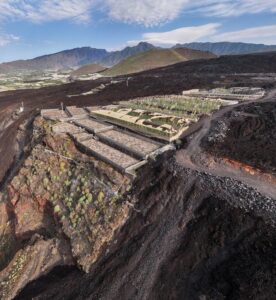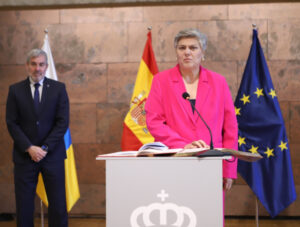04 Jun La Palma Reconstruction – May 2024

La Palma’s Reconstruction: May 2024 Update
News roundup from across La Palma regarding science occurring in La Palma, reconstruction efforts, aid provided to residents and industries, and other relevant news. Sources: La Palma Ahora, Cabildo de La Palma, El Time, ABC España, El Valle de Aridane, El Dia,
Mirame, Planeta Canario, Canarias 7, El Diario, National Geographic
Reconstruction
- Reconstruction law approved – The Reconstruction Law for post-eruption recovery of the island has been approved by the Parliament of the Canary Islands, following its approval in the Cabildo de La Palma in 2023.
-
Help for children living illegally – The Social Action Councillor for the Cabildo de La Palma has announced technical and legal support for families with children, who are part of the group illegally living in areas of La Palma that remain evacuated due to high concentrations of CO2 following the eruption, especially in La Bombilla.
- LP-2 reconstruction – The Cabildo de La Palma are waiting to receive funds from the Canarian Government to be able to begin the 2.3km long reconstruction work on the LP-2 road, the main road to the west of the main that connected Tajuya and Las Manchas prior to the eruption. They wish to start the project as soon as possible, which has been prepared and agreed with help from IGME.
- Electrical grid reconstruction – Endesa, one of the leading energy providers on La Palma, has invested so far €11 million in reconstructing elements of the electricity grid on La Palma. This mostly includes recovery of the medium and low voltage infrastructures on the island that were destroyed during the eruption. Furthermore, they have modified the underground cable network, adding 34 km of cables and innovating to overcome high temperatures in the subsurface following the eruption.
- Tajuya distribution centre – The Tajuya Distribution Centre , has been reconstructed and reopened in Tajuya following its destruction by lava flows during the eruption adding stability to the electrical network in La Palma which was partly lost during the eruption as many were destroyed.
- Los Llanos Infrastructure recover – Los Llanos de Aridane City Council estimates the cost of reconstruction of infrastructure in the municipality of €86 million, and have asked the Government of the Canary Islands and the Government of Spain to update their recovery budget accordingly to help finance this reconstruction. In December 2022, €24 million was given to them for this reconstruction, which was mostly spent on the recovery of roads, but there are still many roads, schools, health centres and other infrastructures such as cemeteries to be recovered.
Aid
- Villa de Mazo reconstruction help – Villa de Mazo, a municipality on the East of La Palma minimally affected by the volcanic eruption, will provide support to those affected by the eruption for reconstruction. It will grant authorisations for construction of residential homes, including holiday homes, by those affected by the eruption, on urban or rural land.
- Bulky collection service – Los Llanos City Council has enabled a collection service for bulky belongings in Puerto Naos, to assist residents in the cleaning of their homes and businesses on their return to the town.
- Additional €1.35 million for homes – The Cabildo de La Palma has modified the budgets allowing €1.35 million to be allocated to projects allowing the construction of new housing plots in the Los Llanos de Aridane, El Paso, and Tazacorte municipalities. It is hoped this can speed up and increase the quality of new housing solutions for those affected by the eruption.
-

Farmers and ranchers denounce “defenselessness” in the face of the poor political management of aid for loss of income after the eruption (El Valle de Aridane)
Concerns over farm aid management – Many local associations have demanded clarity and answers over the reality of aid for farmers affected by the eruption announced by the Government of the Canary Islands earlier this year. For example, it has not yet been published in the official gazette of the Canary Islands despite being announced weeks ago, and it is thought that some farmers have not been included in this aid, going on land area figures.
Science
- Return to Puerto Naos and La Bombilla –
- The Cabildo has authorised access to more areas in Puerto Naos and La Bombilla, including 23 homes in La Bombilla and 17 garages in the Los Lajones area of Puerto Naos, bringing a total of 780 homes now accessible in Puerto Naos and La Bombilla, after they were evacuated due to high CO2 concentrations following the eruption.
- Companies in the leisure sector, including diving and paragliding firms, aim to be able to operate again in the area soon, including by the new lava deltas, and from 3rd June the QR access codes will no longer be in use for all areas except the ‘black’ zone and those homes which have not yet been authorised to return to.
- Residents of Puerto Naos and La Bombilla who were fined for illegally entering the exclusion zone have demanded to the Spanish president to have their fines cancelled. Together, they are close to €40,000, across 40-50 fines
- Puerto Naos beach has recovered its ‘blue flag’ status for the first time since the eruption, meaning it again meets international criteria for environmental quality, sustainability, and services.
- Scientists from the CO2 alter project have considered the reopening of the CEIP school in Puerto Naos to be safe. According to IGN and INVOLCAN, safe levels of gases have not been exceeded inside or outside the school for 5 months, although low concentrations will have to continue for longer before the school is officially reopened.
- Lava flows shallow geothermal test – The University of La Laguna and IGME have completed a shallow geothermal survey up to 100 m below the lava flows, to assess their potential to provide energy to air-condition buildings and generate hot water.
- Health impacts of CO2 – The Health Institute of La Palma have been measuring the impact of the gases in La Bombilla on residents health through measuring CO2 concentrations in blood.

Tests finally begin on residents in La Bombilla to find out the real effect of CO2 on their health (El Valle de Aridane)
- New 3D model of Tajogaite – INVOLCAN have shared on social media a new 3D model on the cone of Tajogaite, created using a new 3D laser scanning technology, with precision of up to 1 mm.
- Teleseismic survey of La Palma – A team of researchers from INVOLCAN, ITER and Complutense University of Madrid have imaged seismic velocities to infer crustal structure in the first 50 km beneath La Palma, using teleseismic data. The main interpretations include two magma bodies at around 13 km and 30 km respectively, based on velocities and locations of earthquakes during the eruption. The amount of magma inferred in these chambers is thought to be greater than previously estimated, based on these results.
- ‘Isla Lab’ construction project – A project to research using lava and ash from the volcano to reconstruct homes on the island, called Isla Lab, has been announced as a collaboration between the Cabildo de La Palma and the University of Navarra in architectural and construction research.
- New technique forecasts end of eruption – New research led by INPA-CSIC, has presented a technique based on the subsidence of land around the volcano during the eruption recorded by GNSS stations, that uses ideas about the physics of volcanoes to forecast when a volcanic eruption may end. It was successfully applied to La Palma, giving an estimate of between 79-92 days. If a volcano is erupting and no new magma is flowing into the chamber, then there should be a stabilisation over time of ground movement around the volcano, at which point the eruption should stop.
Other updates
Thanks Multicines Millennium, Los Llanos de Aridane, La Palma, for hosting us tonight.
After 2 years of work and before we launch @LavaBombsFilm 2: The Reconstruction on platforms, it’s important to share + discuss it with locals first. Nerve wracking though 😅 #fuerzalapalma pic.twitter.com/e9A0g2zVQA— Sharon Backhouse (@GeoTenerife) May 15, 2024
- Lava Bombs 2 Showing on La Palma – The documentary Lava Bombs 2, co-produced by GeoTenerife, was shown in the Multicines Milennium Cinema in Los Llanos de Aridane, to a crowd that included affected residents, local scientists, as well as politicians involved in the reconstruction of the island. The documentary is the second following the eruption and reconstruction of La Palma following the Tajogaite eruption, from the perspectives of those involved and affected.
-

Eight palm associations invite the new Transparency commissioner to put an end to “the kidnapping of the PEVOLCA minutes and recordings” (El Time)
Transparency of PEVOLCA meeting minutes – Eight associations representing those affected by the eruption have demanded the new Transparency Commissioner of the Canary Islands to u-turn on their predecessor and release minutes from PEVOLCA meetings before and during the eruption, which was previously demanded but rejected.
- No more in hotels – The last of the affected residents being housed in hotels following the eruption has left, as the Cabildo de La Palma decided to stop financing hotel stays for the remaining 16 residents and instead give them housing alternatives, although all of these residents have accepted the housing offer.


No Comments